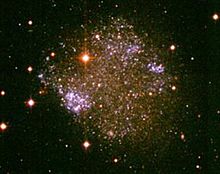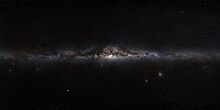Local group

The galaxy group in which the Milky Way is located is called the local group . The local group is 5 to 8 million light years in diameter .
The Milky Way and Andromeda Galaxy are the two largest galaxies in the Local Group. There are around seventy dwarf galaxies in their immediate vicinity . In addition, the local group contains some smaller galaxies that cannot be assigned to either of the two centers.
properties

Objects within a radius of five to eight million light years are counted in the local group. It is assumed that the members of this group are gravitationally bound to one another, so that belonging to the local group arises from a real physical bond and does not just represent a random geometric structure in the universe. The members of the local group form an approximately ellipsoidal cluster. Most of the visible mass is in the Milky Way Galaxy and Andromeda Galaxy (about 95%).
The members of the group are not evenly distributed in the pile. Depending on their gravitational ties, they gather to form several subgroups. These include the Milky Way subgroup , with the Milky Way and its satellite galaxies, and the Andromeda subgroup , with the Andromeda galaxy and its satellites. The Triangle Nebula probably belongs to the Andromeda subgroup or forms its own subgroup with its satellite galaxy LGS 3. A third (or fourth) possible subgroup is clustered around the galaxy NGC 3109 , but it is not certain whether this still belongs to the local group. Other galaxies that none of these sub-groups can be assigned to form the Local Groups cloud ( Local Group Cloud ). These galaxies move in the common gravitational field formed by the large galaxies.
While it was previously assumed that the Andromeda galaxy is the most massive galaxy in the Local Group, well ahead of the Milky Way, more recent studies indicate the opposite. According to this, Andromeda's total mass is around 800 billion solar masses, while the galaxy has a good 1.5 trillion solar masses.
According to computer simulations, the local group should contain around 300 to 500 dwarf galaxies. However, only about 70 are known at the moment. Some astronomers therefore assume that the previously undiscovered galaxies largely consist of dark matter and hardly contain any stars and are therefore so-called dark galaxies .
Subgroups and known objects of the local group
- See also: List of Galaxies in the Local Group
Milky Way subgroup
The Milky Way subgroup includes at least 28 galaxies.
- the milky way
- the Large Magellanic Cloud (ESO 56-115)
- the Small Magellanic Cloud (NGC 292)
- the elliptical Sagittarius dwarf galaxy (SagDEG)
- the Sculptor dwarf galaxy
- the Canis Major Dwarf Galaxy
- the Fornax dwarf galaxy
- the Draco dwarf galaxy
- the Carina dwarf galaxy
- the Phoenix dwarf galaxy
- the Ursa Minor dwarf galaxy
- the Hercules dwarf galaxy
- the Sextans dwarf galaxy
- the Pisces-I dwarf galaxy
- the Pisces II dwarf galaxy
- the Coma Berenices dwarf galaxy
- the dwarf galaxies Ursa-Major-I and Ursa-Major-II , as well as Canes-Venatici-I and Canes-Venatici-II
- the dwarf galaxies Leo I , Leo II , Leo IV , Leo V and Leo T , as well as Bootes I , Bootes II and Bootes III
- the dwarf galaxy Segue 2
Andromeda subgroup

- See also: List of satellite galaxies of Andromeda
The Andromeda subgroup includes at least 37 galaxies.
- the Andromeda Galaxy (Andromeda Nebula, M 31)
- M110 (NGC 205, Andro-Alpha)
- M32 (NGC 221, Andro-Beta)
- the dwarf galaxies And I to And XXIX (including the spheroid Pegasus and Cassiopeia dwarf galaxies )
- NGC 147 and NGC 185
- IC 10
- the triangle nebula (M 33, NGC 598, triangular galaxy)
- the Pisces dwarf galaxy (LGS 3)
NGC-3109 subgroup
The NGC-3109 subgroup includes at least four galaxies:
Local group cloud
- Barnard's Galaxy (NGC 6822)
- the Aquarius dwarf galaxy
- the Cetus dwarf galaxy
- IC 1613
- Wolf-Lundmark-Melotte
- the irregular Sagittarius dwarf galaxy (SagDIG)
- the Leo III dwarf galaxy (Leo A)
- the Tucana dwarf galaxy
Surroundings
The local group is part of the Virgo supercluster , which is named after the Virgo cluster at its center. Within this supercluster, the Local Group borders on the Maffei , Sculptor , M81 , CVn-I and M83 groups . The Virgo supercluster, in turn, is part of the Laniakea supercluster due to its position and direction of movement .
The mass abundance of the central Virgo cluster leads to a gravitational attraction of the local group, which is superimposed with the general cosmological Hubble flow - the general expansion of the universe . The cosmological redshift of the galaxies of the Virgo cluster is therefore much lower at around 1000 km / s than one would expect at the given distance. With a modern value for the Hubble constant H 0 = 73 km / s / Mpc, about 1400 km / s would be expected - this value is e.g. B. from the Fornax galaxy cluster with a lower mass, which is almost equally distant at about 60 million light years . The difference in speed between the Hubble flow and the actual speed of the local group corresponds to a relative movement towards the Virgo cluster and is called Virgo Infall .
See also
- Structure of the cosmos
- Position of the earth in the universe
- Andromeda Milky Way Collision
- Maffei group
- M81 group
- M83 group
- Sculptor group
- Canes Venatici I group
literature
- Sidney Van den Bergh: Galaxies of the local group. Cambridge Univ. Press, Cambridge 2000, ISBN 0-521-65181-6
- Andrew Layden: The local group. ESO, Garching 1994, ISBN 3-923524-54-4
Web links
- The local group at SEDS (English)
- Local [email protected] : An overview of the members of the local group
- Information about Canis Major
- A compilation of the members of the local group ( Memento from January 25, 2008 in the Internet Archive )
Individual evidence
- ↑ Local group. In: Spektrum.de. Retrieved April 27, 2019 .
- ↑ Researchers have recalculated the mass of the Milky Way - it changes the view of our galaxy
- ↑ Prajwal Kafle (ICRAR / The University of Western Australia), Pete Wheeler (Media Contact, ICRAR): Milky Way ties with neighbor in galactic arms race , February 15, 2018, accessed March 16, 2019.
- ^ L. Watkins, R. van der Marel, S. Sohn, W. Evans: Evidence for an Intermediate-Mass Milky Way from Gaia DR2 Halo Globular Cluster Motions. In: The Astrophysical Journal. Volume 873, No. 2, March 2019; see. ESA article , accessed March 16, 2019.
- ↑ NASA / IPAC Extragalactic Database. In: Results for Virgo Cluster. Retrieved October 14, 2007 .
- ↑ F. Combes et al .: Galaxies and Cosmology , Springer A&A Library (1995), Chapter 11.6: Large Scale Motions. Virgo Infall





